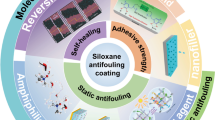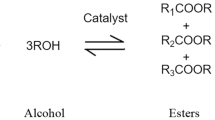Abstract
Inorganic fullerene-like molybdenum disulfide (IF-MoS2) nanoparticles are known to exhibit great friction and wear-reducing abilities in severe boundary lubrication regimes, when added to a base oil alone. Their use in fully formulated lubricants was investigated in this study, and the tribological benefits attributed to the IF-MoS2 nanoparticles were found to be lost in the presence of dispersants. Various experimental techniques were used on three reference oils (base oil containing only IF-MoS2, only dispersants and both IF-MoS2 and dispersants) in order to understand the effect of succinimide-based dispersants on the three phases needed for effective nanoparticle-based lubrication, namely (1) the passing of the nanoparticles through the contact (2) the exfoliation of the IF-MoS2 inside the contact and (3) the adhesion of the released MoS2 platelets on the friction surfaces. The dispersants were shown to improve the dispersion of the nanoparticles in the oil by reducing their agglomeration, but prevented the adhesion of a low-friction MoS2 tribofilm on the steel surfaces. In-situ contact visualization revealed that the well-dispersed nanoparticles passed through the contact and exfoliated nanoparticles were observed after tribological testing. These results imply that nanoparticle dispersion itself does not seem to be an issue concerning nanoparticle effectiveness, even though the reduced agglomerate size and inertia may have affected nanoparticle flow near the contact, as well as entrapment and exfoliation conditions inside the contact. The use of succinimide-based dispersants may, however, have affected the tribochemistry of the contact, by an excessive adsorption on the steel surfaces and/or by encapsulating the released MoS2 platelets, preventing tribofilm adhesion. A balance was finally found between nanoparticle dispersion and friction reduction, but for very low dispersant concentrations and after a running-in period. The role of succinimide-based dispersants and their effect on nanoparticle lubrication were discussed in the light of these results.

















Similar content being viewed by others
References
Tenne, R.: Advances in the synthesis of inorganic nanotubes and fullerene-like nanoparticles. Angew. Chem. Int. Ed. Engl. 42, 5124–5132 (2003)
Bakunin, V.N., Suslov, A.Y., Kuzmina, G.N., Parenago, O.P., Topchiev, A.V.: Synthesis and application of inorganic nanoparticles as lubricant components: a review. J. Nanoparticle Res. 6(2), 273–284 (2004)
Bar-Sadan, M., Kaplan-Ashiri, I., Tenne, R.: Inorganic fullerenes and nanotubes: wealth of materials and morphologies. Eur. Phys. J. Spec. Top. 149(1), 71–101 (2007)
Joly-Pottuz, L., Matsumoto, N., Kinoshita, H., Vacher, B., Belin, M., Montagnac, G., Martin, J.M., Ohmae, N.: Diamond-derived carbon onions as lubricant additives. Tribol. Int. 41(2), 69–78 (2008)
Joly-Pottuz, L., Dassenoy, F., Martin, J.M., Vrbanic, D., Mrzel, A., Mihailovic, D., Vogel, W., Montagnac, G.: Tribological properties of Mo-S-I nanowires as additive in oil. Tribol. Lett. 18(3), 385–393 (2005)
Cizaire, L., Vacher, B., Le Mogne, T., Martin, J.M., Rapoport, L., Margolin, A., Tenne, R.: Mechanisms of ultra-low friction by hollow inorganic fullerene-like MoS2 nanoparticles. Surf. Coatings Technol. 160(2–3), 282–287 (2002)
Rosentsveig, R., Gorodnev, A., Feuerstein, N., Friedman, H., Zak, A., Fleischer, N., Tannous, J., Dassenoy, F., Tenne, R.: Fullerene-like MoS2 Nanoparticles and Their Tribological Behavior. Tribol. Lett. 36(2), 175–182 (2009)
Joly-Pottuz, L., Martin, J.M., Dassenoy, F., Belin, M., Montagnac, G., Reynard, B., Fleischer, N.: Pressure-induced exfoliation of inorganic fullerene-like WS2 particles in a Hertzian contact. J. Appl. Phys. 99(2), 023524 (2006)
Lahouij, I., Dassenoy, F., Vacher, B., Martin, J.-M.: Real Time TEM Imaging of Compression and Shear of Single Fullerene-Like MoS2 Nanoparticle. Tribol. Lett. 45(1), 131–141 (2012)
Lahouij, I., Dassenoy, F., Knoop, L., Martin, J.-M., Vacher, B.: In situ TEM observation of the behavior of an individual fullerene-like MoS2 nanoparticle in a dynamic contact. Tribol. Lett. 42(2), 133–140 (2011)
Tannous, J., Dassenoy, F., Lahouij, I., Mogne, T., Vacher, B., Bruhács, A., Tremel, W.: Understanding the tribochemical mechanisms of IF-MoS2 nanoparticles under boundary lubrication. Tribol. Lett. 41(1), 55–64 (2011)
Lahouij, I., Vacher, B., Martin, J.-M., Dassenoy, F.: IF-MoS2 based lubricants: influence of size, shape and crystal structure. Wear 296(1–2), 558–567 (2012)
Nikas, G.K., Sayles, R.S., Ioannides, E.: Effects of debris particles in sliding/rolling elastohydrodynamic contacts. Proc. Inst. Mech. Eng. Part J-Journal Eng. Tribol. 212(J5), 333–343 (1998)
Rabaso, P., Ville, F., Dassenoy, F., Diaby, M., Afanasiev, P., Cavoret, J., Vacher, B., Le Mogne, T.: Boundary lubrication: influence of the size and structure of inorganic fullerene-like MoS2 nanoparticles on friction and wear reduction. Wear (2014, submitted)
Acknowledgments
The authors would like to express their gratitude to the CLYM (Centre LYonnais de Microscopie) and to Pavel Afanasiev from IRCELYON (Institut de Recherches sur la Catalyse et l’Environnement de Lyon) for their precious help, to LUBRIZOL for providing the base oil and the dispersants used in this study, as well as to the ANRT (Association Nationale de la Recherche et de la Technologie) for their support.
Author information
Authors and Affiliations
Corresponding author
Rights and permissions
About this article
Cite this article
Rabaso, P., Dassenoy, F., Ville, F. et al. An Investigation on the Reduced Ability of IF-MoS2 Nanoparticles to Reduce Friction and Wear in the Presence of Dispersants. Tribol Lett 55, 503–516 (2014). https://doi.org/10.1007/s11249-014-0381-5
Received:
Accepted:
Published:
Issue Date:
DOI: https://doi.org/10.1007/s11249-014-0381-5




